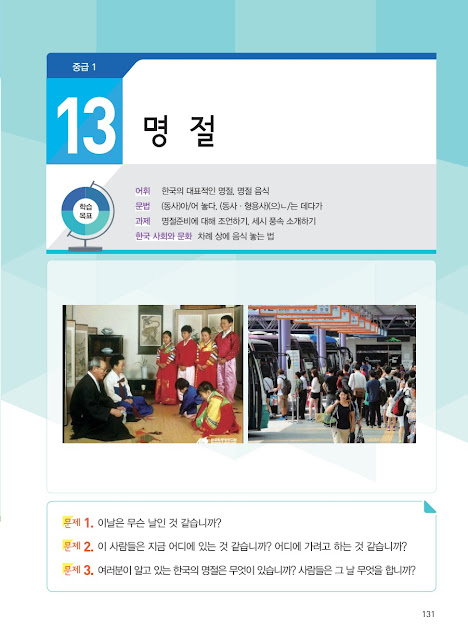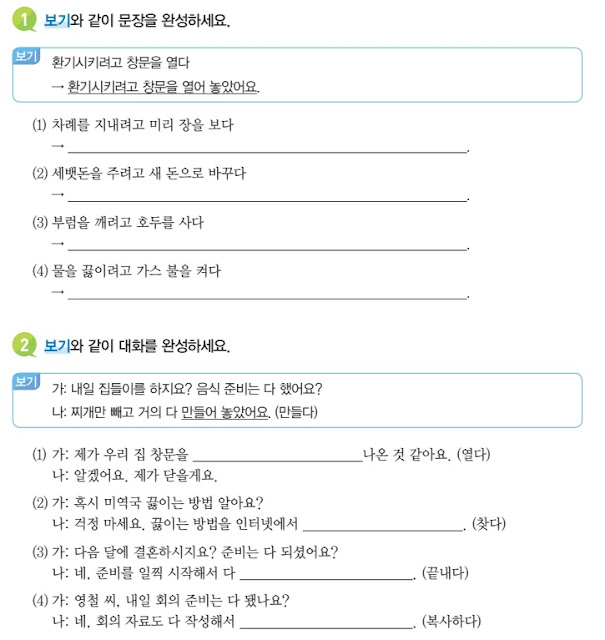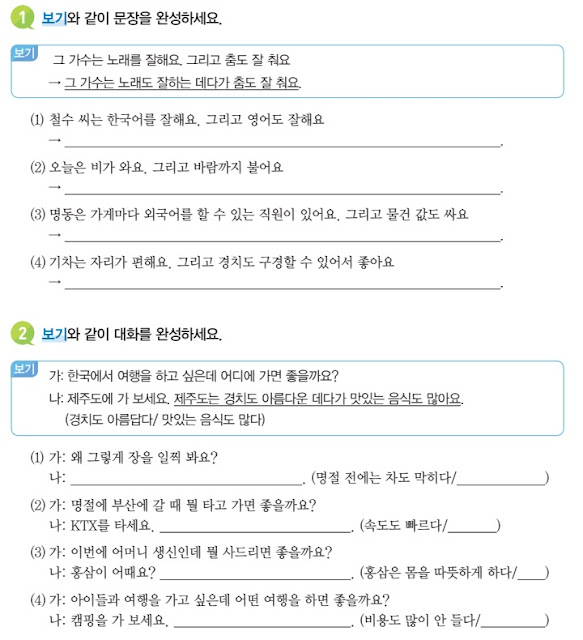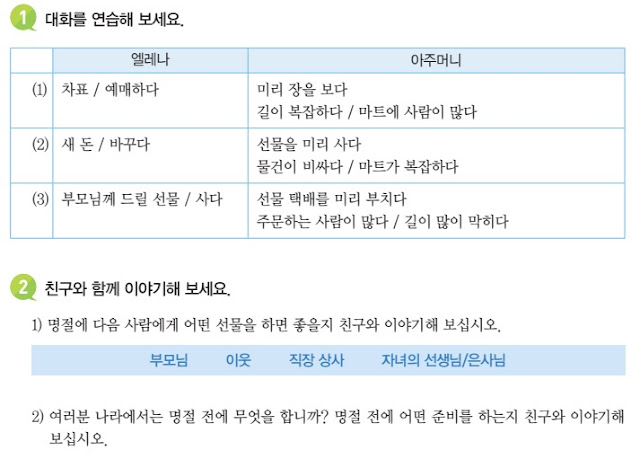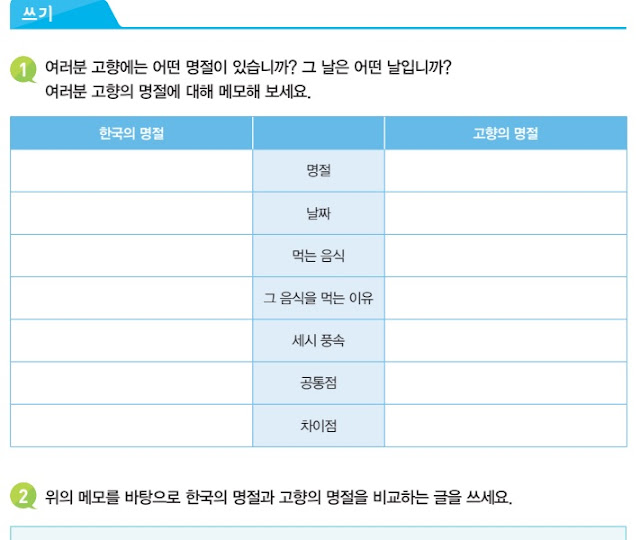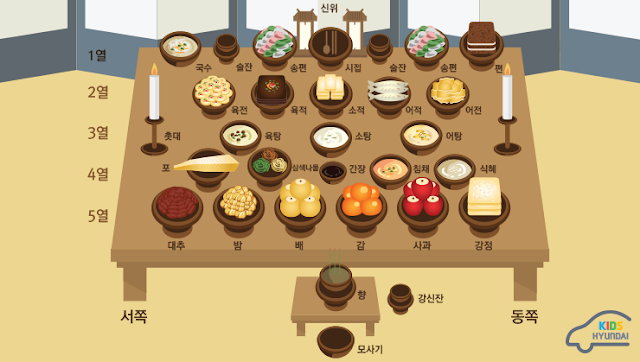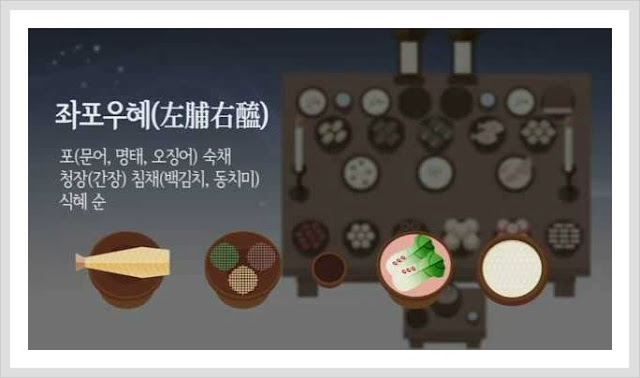문제 1. 이날은 무슨 날인 것 같습니까?
문제 2. 이 사람들은 지금 어디에 있는 것 같습니까? 어디에 가려고 하는 것 같습니까?
<Page 132> 1. 한국의 대표적인 명절: Korea’ s Typical Holidays
– ‘설’은 새해의 첫머리라는 뜻으로 새해의 안녕과 건강을 기원하는 날
(새해 new year
첫머리 beginning; opening
안녕 peace
기원하다 to pray, to wish )
– 설빔을 입다: to wear new clothes in a new year
– 차례를 지내다: to hold ancestral rites
– 세배를 하다: to do New Year’s bow to the elder members
– 덕담을 하다: to give words of blessing
– 세뱃돈을 받다: to received some gift money
– 떡국을 먹다: to eat rice-cake soup
– 복조리를 걸다: to hang bokjori (lucky strainer: A strainer hung up on the wall in the early morning of Seollal, Lunar New Year’s Day, in the belief that it brings good luck for the year)
– 제기차기: A traditional Korean game where players kick a jegi, a traditional Korean toy.
– 연날리기: kiteflying
– 윷놀이 등의 놀이를 함: Playing games such as game of Juk
** 함 = 하다 + 음 (Some verbs + 음 => Nouns).
추석(음력 8월 15일) Chuseok (August 15th of the lunar calendar)
– 한 해의 농사가 무사히 끝난 것을 조상에게 감사드리는 날
(농사: farming;
무사히: safe; intact;
조상: ancestor; ancestry)
– 송편을 빚다: to make songpyeon (A tteok, a rice cake, made by putting in different grains such as adzuki beans, beans, sesame, etc., inside a rice powder dough, working it into a half-moon shape and steaming it on pine needles.)
– 성묘를 하다: to visit and pay one’s respects at sb’s grave.
– 벌초를 하다: to visit to cut weeds around a family member’s grave
– 보름달을 보고 소원을 빌다: to wish upon the full moon
– 줄다리기: tug-of-war
– 강강술래 등의 놀이를 함: Playing game such as ganggangsulae (a traditional Korean circle dance play by women under the bright full moon)
<Page 133> 2. 명절 음식: Korea Traditional Festival foods

동지(대설 15일 후) 동지 (After 대설 15 days)
동지: One of the 24 seasonal divisions, said to have the longest night of a year; it falls on December 22nd
대설: One of the 24 seasonal divisions, said to have the heaviest snowfall of a year; it falls on around December 8th.
(팥: Red bean;
붉: red;
잡귀: sundry demons;
몰아내다: to drive out, to expel)
– 새알심을 나이만큼 먹기도 함: They also eat a number of small dumplings in red-bean gruel (새알심) as many as their age)
(새알심: a small dumpling in red-bean gruel)
대보름(음력 1월 15일) The first full moon of a year ( January 15th of the lunar calendar)
부스럼이 안 생기고 치아가 건강해진다고 함. 귀가 밝아지고 눈이 잘 보인다고 함
(부스럼: boil, abscess, carbuncle;
치아: tooth,
건강해지다: to grow strong in health; 귀: ear;
밝아지다: to brighten;
보이다: to be viewed; to be visible; to be in sight)
설날(음력 1월 1일): Lunar new year ( January 1st of the lunar calendar)
긴 가래떡처럼 무병장수하고 흰 떡처럼 새해에는 깨끗해지라는 의미
처럼: like, as..as…
무병장수: good health and long life, health and longevity;
희다: white;
깨끗해지다: to become cleaner,
의미: meaning, sense)
추석(음력 8월 15일): Chuseok (August 15th of the lunar calendar)
수확한 햅쌀로 떡을 만들어 한 해 농사를 잘 마친 것을 조상에게 감사함.
(수확한 햅쌀: newly harvested rice;
농사: farming, farm work;
마치다: to end, finish (off), to close, to complete;
조상: ancestor; ancestry)
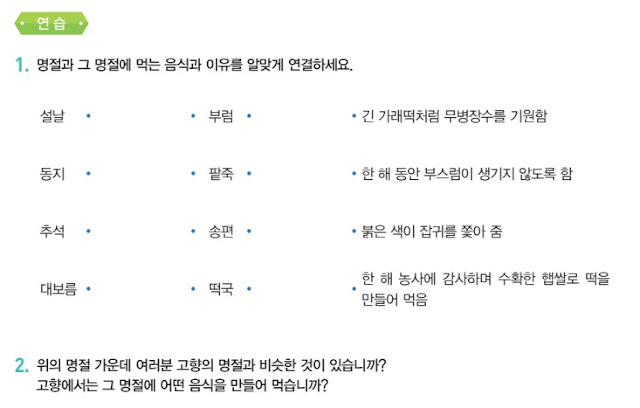
연 습:
– 부럼: A hard fruit such as peanuts, chestnuts, walnuts, etc., which one eats on January 15th of the lunar calendar by crunching on the nut in order to ward off all the evils for a year.
– 가래떡: Rice cake in round stick form, which is white, long, and thin.
– 무병장수: good health and long life, health and longevity;
– 기원하다: to wish, to pray
– 팥죽: Red-bean porridge:
– 부스럼: boil, abscess, carbuncle
– 송편: songpyeon, half-moon-shaped rice cake
– 잡귀: sundry demons
– 쫓다: to drive out
– 농사: farming
– 수확한 햅쌀: newly harvested rice
<Page 134 – 135> 문법
1. V+ 아/어 놓다: Click here to see in details
The grammar expresses that someone does something in advance for future use
•다음 달에 고향에 갔다 오려고 비행기 표를 예약해 놓았어요.
•어머니 생신 선물을 보내려고 인삼을 사 놓았어요.
•추석 전에는 차가 많이 막히니까 미리 장을 봐 놓아야겠어요.
•아이들에게 세뱃돈을 줘야 하니까 새 돈으로 바꾸어 놓으세요.
– 장을 보다: to do grocery shopping
– 세뱃돈: New Year’s cash gifts given to younger ones after receiving bows from them
– 환기시키다: to air out
– 차례: ancestral rites
– 부럼: A hard fruit such as peanuts, chestnuts, walnuts, etc., which one eats on January 15th of the lunar calendar by crunching on the nut in order to ward off all the evils for a year.
– 끓이다: to boil
– 가스 불을 켜다: to turn on the stove
– 빼다: to take out; to draw; to pull out
– 자료 작성하다: to draw up material
– 복사하다: to copy

2. V/A+ (으)ㄴ/는 데다가: Click here to see the grammar in details
You can translate into English such as: “not also… but also”, “additionally”
– 정신: mind, spirit; soul
– 자리: room (for), space (for), seat
– 편하다: comfortable; easy; peaceful
– 캠핑: Camping
– 비용이 들다: To cost
<Page 136> 말하기
– 아주머니: 엘레나 씨는 이번 설날에 무슨 계획이 있어요?
– 엘 레 나: 시댁에 가려고요. 그런데 시댁에서 처음 보내는 명절인데 뭘 어떻게해야 할지 모르겠어요.
– 아주머니: 명절 때는 길이 무척 막히는데 차표는 예매해 놓았어요?
– 엘 레 나 : 네, 표는 예매해 놓았어요. 또 뭘 준비해야 할까요?
– 아주머니: 미리 장을 봐 놓아야지요. 명절 전에는 길도 복잡한 데다가 마트에 사람도 많으니까 장도 미리 봐 놓는 게 좋아요
Vocabulary:
– 시댁: one’s husband’s home
– 무척: very; extremely
– 차표: bus ticket; train ticket
1. (3)- 부치다: to send
2.
– 직장 상사: superior officer at work
– 자녀: children, sons and daughters
– 은사: teacher
<Page 137> 듣기
상호 : 쿤 씨, 내일부터 설날 연휴인데 뭐 할 거예요?
쿤 : 고향에는 못 돌아가니까 베트남 친구들하고 모여서 베트남 설음식을 만들어 먹으려고요.
상호 : 베트남에서도 설을 지내요?
쿤 : 그럼요. 저희도 음력 1월 1일이 설날이에요. 그렇지만 베트남은 12월이 음력으로 29일까지 있어서 설날이 한국보다 하루 빨라요.
상호 : 그렇군요. 그럼 베트남에서는 설날에 어떤 음식을 먹어요?
쿤 : 한국 사람이 떡국을 먹는 것처럼 베트남에서는 ‘반쯩’이라는 걸 먹어요. 찹쌀떡 안에 돼지고기와 녹두를 넣고 찐 음식이에요.
상호 : 이야기를 들으니까 만두랑 비슷할 것 같은데요.
쿤 : 맞아요.
상호 : 한국 사람들은 설날에 세배도 하고 세뱃돈을 받는 풍습이 있는데 베트남은 어때요?
쿤 : 저희도 이웃이나 친척을 찾아가서 서로 덕담을 나누고 아이들에게는 돈을 주기도 해요. 그렇지만 세배는 하지 않아요.
Vocabulary
설음식 festive dishes for the New Year
반쯩 Ban Chung (a traditional Vietnamese cake)
찹쌀떡 sticky rice cake
녹두 mung beans; green gram
만두 Dumplings, made by kneading and pressing flour and wrapping minced meat, vegetables, etc., with the dough.
이웃 neighbor
친척 relative
찾아가다 to go visiting
덕담 words of blessing; well-wishing remarks
2. 잘 듣고 질문에 답하세요.
① 설날에 먹는 특별한 음식이 있다.
② 세배를 한다.
③ 이웃이나 친척과 덕담을 주고 받는다.
2) 들은 내용과 같으면 O표, 다르면 X표 하세요.
(1) 베트남의 설날은 한국과 같은 날이다. ( )
(2) 베트남과 한국 모두 설날에 아이들에게 세뱃돈을 준다. ( )
– 풍습: manners and customs
– 특별하다: special
– 세배하다: To perform new year’s bow
– 친척: relative
– 덕담: words of blessing; well-wishing remarks
<Page 137> 발음
1. 다음 발음을 잘 듣고 따라하세요.
1) 미리 사 놓으세요 2) 기분이 좋은 것 같아요
3) 첫째 딸을 낳았어요 4) 내지 않은 사람이 있어요
1) 길이 막히니까 장을 미리 봐 놓으세요.
2) 요즘 그 사람 기분이 좋아 보여요.
3) 아직 회비를 내지 않은 사람이 있어요.
– 낳다: to give birth to
< Page 138> 읽기

1. 여러분의 고향에는 어떤 명절들이 있습니까? 그 명절에 먹는 특별한 음식은 무엇입니까?
여러분 고향에서는 보통 명절에 무슨 음식을 먹습니까? 한국의 대표적인 명절 음식으로는
설날에 먹는 ‘떡국’을 들 수 있습니다. 떡국은 흰 가래떡을 썰어서 끓인 음식입니다. 가래의 긴 모양은 무병장수를 뜻하고 흰색은 한 해의 때를 벗고 깨끗해지라는 뜻이라고 합니다. 그리고 한국 사람들은 떡국 한 그릇을 먹으면 나이를 한 살 더 먹는다고 생각해서 ‘떡국 몇 그릇이나 먹었어?’라는 질문을 하기도 합니다.
– 가래떡: Rice cake in round stick form, which is white, long, and thin
– 썰다: To slice; to cut
– 끓이다: to boil
– 모양: shape
– 무병장수: good health and long life, health and longevity
– 벗다: To take off, undress, to strip (off), to remove, to slip off
– 깨끗해지다: To become cleaner
– 뜻: meaning, intention
– 그릇: bowl, container, basin
– 한편: on the other hand; meanwhile; same side, one side
– 빼놓다: to leave (sb/sth) out
– 송편: songpyeon (a tteok, a rice cake, made by putting in different grains such as adzuki beans, beans, sesame, etc., inside a rice powder dough, working it into a half-moon shape and steaming it on pine needles)
– 농사 짓다: to do farming
– 햅쌀: newly/ freshly harvested rice
– 햇곡식: a new crop of grain
– 고생하다: to go through a hardship; to have difficulty
– 서로: each other, one another
– 위로하다: to console; to comfort
– 돌보다: to take care of
– 조상: ancestor; ancestry
– 의미: meaning, sense
– 정월 대보름: the 15th day of the New Year according to the lunar calendar, the day of the first full moon of the lunar year
– 오곡밥: five-grain rice
– 부럼: A hard fruit such as peanuts, chestnuts, walnuts, etc., which one eats on January 15th of the lunar calendar by crunching on the nut in order to ward off all the evils for a year.
– 귀밝이술: ear-quickening wine (served on the first full moon day of the lunar new year)
– 부스럼: boil, abscess, carbuncle
– 챙기다: to pack, to take, to look after
– 이빨: tooth (teeth)
– 깨다: to break
– 믿다: To believe; to trust
– 절기: Any of the twenty four seasonal divisions of the year
– 팥죽: Red-bean porridge
– 끓이다: to boil, to heat
– 대문: A large door for one’s entrance and exit
– 뿌리다: to sprinkle (sth on/over sth)
– 막다: to block; to close; to fend off, to prevent, to stop
– 지키다: to guard; to defend; to keep, to obey
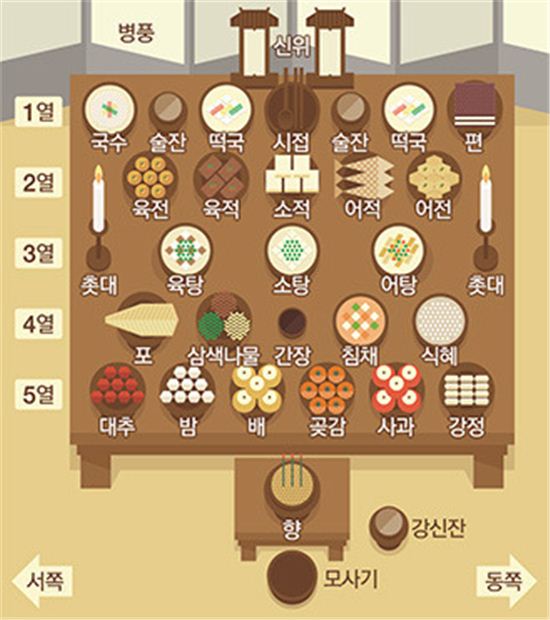
한국의 명절에 하는 일 가운데 가장 중요한 일은 차례를 지내는 것이다. 그런데 차례 상에 음식을 차릴 때는 음식을 놓는 위치가 정해져 있다. 그 규칙 가운데 몇 가지를 소개하면 다음과 같다.
차례 상 memorial service table
차리다 to set the table
정해지다 to be set, to be fixed, to be arranged, to be settled, to be decided, to be determined
포 (문어: octopus jerky, 명태: pollack jerky, 오징어: octopus jerky)
식혜 sikhye: sweet rice drink
대추: A fruit that tastes sweet and looks like a small bird’s egg, and whose skin becomes red when ripe
밤: chestnut
배: pear
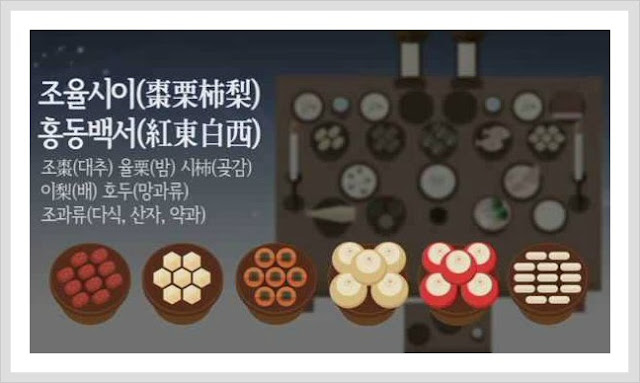
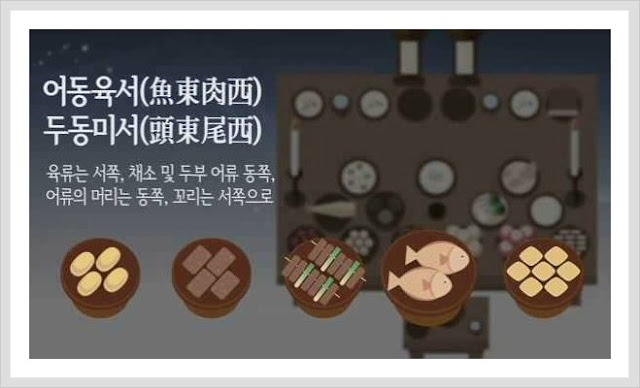
>> For studying other lessons of KIIP level 3: CLICK HERE
>> My facebook: Say Hi Korean (Click here)

